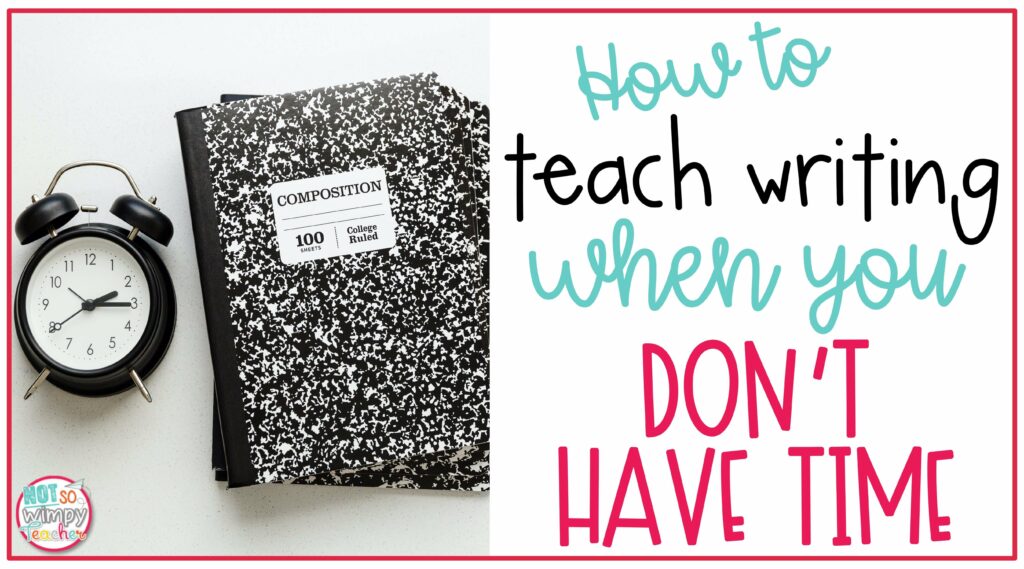
There are so many subjects competing for your instructional time. Math, reading, spelling, science, social studies, and grammar. So many lessons to teach, tasks to check off, standards to measure . . . . And now you need 30-45 minutes to teach writing!?! Everyday?
I know it seems impossible. Your plate is filled to the edge, kind of like on Thanksgiving Day when you can’t even find a spot for the cranberries. And yet, you’re constantly being asked to teach “just one more thing.”
When you look down at your plans each week, you can’t help but notice one subject that’s missing: writing. And it makes you feel just a little bit uncomfortable. Maybe even guilty.
Today I’m going to help you find the time to teach writing. So you never have to worry about squeezing it in again.
Do a Time Audit
Have you ever done a time audit? This exercise asks you to record how you spend every minute of your workday. I know it sounds tedious, but it provides so much valuable information and insight.
As a teacher, you are already ahead of the game. You have a specific time that school starts and ends. Your specials, lunch, and even recess are at the same times each day. And you have a general timetable for your major subjects. It’s probably posted on your whiteboard.

But I want you to pay attention to how you actually spend your time during the school day. If you’re anything like I was, very few days actually mirror your posted schedule. You’ve got assemblies and birthdays and other special events to contend with. Assessments, holiday parties, and special group lessons all compete for space on your daily schedule.
Take a week and track how you actually spend your time. See which subjects get cut to squeeze in all those extra lessons and special events. How well are you sticking to your schedule? Pay special attention to the beginning and end of the school day and to your transition time.
Must-Dos versus May-Dos
Once you’ve completed your time audit, take all the activities you wrote down and divide them into two categories: Must-Do activities and May-Do activities.
Your Must-Do Activities include your standards-based subjects: math, reading, grammar, etc… Your May-Do activities are the things you aren’t required to teach, but that make your classroom fun and unique. Examples include STEAM explorations, morning meetings, brain breaks, crafts, and bell work.
Is there anything on your May-Do list that you don’t have to do? Or maybe something you could do less frequently? Could you reduce the morning meeting from twenty minutes to ten? Or do STEAM explorations only on Fridays? Even a small shift could give you the time you need to teach writing.
I’m not suggesting you eliminate all the fun activities that make your classroom a place kids love. But maybe, when you see how much time you spend on random May-Do’s, you can reduce some of them to make more time to teach writing.
You should also look critically at your Must-Dos. Yes, you have to teach math. But are you letting your math lessons creep into your next subject? It’s not uncommon to let a subject carry over by just a few minutes. Especially the subjects we like best. Over time, though, all those extra minutes add up.

Find Time to Teach Writing
Revisit Routines
Look at your time audit and see if you can find any pockets of wasted time. Examples include taking too long to transition from one subject to the next, taking too long to get all the students to the carpet, or getting back from lunch or recess late. Once you see where there’s wasted time, you can revisit and even rethink classroom routines to streamline transitions and save time to teach writing.
How long does it take you to take attendance and sort through paperwork in the morning? Are you wrapping up morning work and starting math on time? Or do you find yourself starting just a few minutes late every day? Over the course of a week, starting math just five minutes late adds up to twenty-five minutes!
Take a look at how much time you are spending in transit. Are you getting to special on time? Even more important, are you picking your students up from specials and lunch on time and heading directly back to the classroom? Or are you stopping to chat with teacher friends on the way? Or running into the office for “just one copy?”
This is a judgment-free zone. We’ve all been there. But until you write it all out on paper, it’s easy to overlook how these tiny distractions take up valuable time that you could use to teach writing.
Also, pay attention to how long it takes your students to move through the classroom. If you find that you are wasting a lot of time getting centers set up or gathering supplies, maybe simply rearranging your classroom set-up can help to optimize flow and reduce wasted time.
It’s important to revisit routines throughout the school year to remind kids of your expectations. And it’s okay to change things that aren’t working.
Time Transitions
Take a few days and time your students during transitions. See how long it takes them to get settled in the morning and pack up in the afternoon. How long does it take to come to the carpet, move to math centers, or find a spot for independent reading? How much time does it take to line up for specials, lunch, and recess?
Once you have a baseline for these transitions, challenge your students to do better. Project a timer on your whiteboard and have your students race against time. Or create a contest between groups or rows to see which group can get ready the fastest. You might even come up with a reward if the students beat a goal you set for them. Students love these kinds of challenges.
Prepare for the Entire Day
Last but certainly not least is to start each school day prepared to teach every subject you are going to teach that day.
Have teacher manuals at hand and open them to the correct page. Collect every worksheet, activity, and homework page your students will need and place them all together in an easy-to-access place.
Don’t forget to open up PowerPoints, videos, and any computer programs you might need in new tabs and have them ready to go. Make sure you have a supply of sharpened pencils and dry-erase markers.
I know these sound like small things, but they can make a big difference. When you are prepared for the entire day, not only do you reduce wasted time, but you also feel calmer and more confident. And your students stay more focused and engaged.
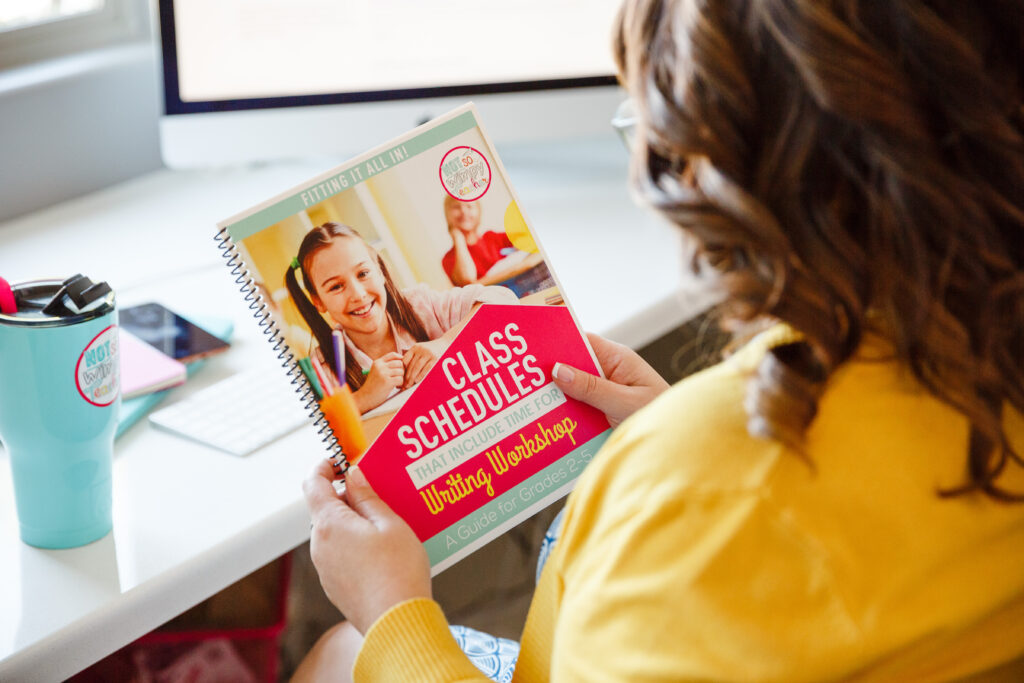
Sample Schedules with Time to Teach Writing
Would you like to see how other teachers have successfully implemented writing workshops in their classrooms? Of course you would! Who doesn’t enjoy a peek into someone else’s classroom?
We’ve put together a handy guide that shows how several different teachers have found time for writing workshop. I know these schedules won’t work perfectly for you. Everyone has their own unique schedule but seeing how others have fit writing into their day might inspire you in a way you haven’t thought of.
To learn more about how to set up a writing workshop once you’ve found the time to teach writing check out this post.
Learn More About How to Teach Writing
If you’re looking for more tips on teaching writing, you might like How to Plan an Entire Year of Writing Lessons, How to Teach Writing When You Don’t Have Time, or 5 Things You Don’t Have to Do When Teaching Writing.
Not So Wimpy Writing Masterclass
And, if you want more tips on how to make teaching writing easier, you’ll love my Not So Wimpy Writing Masterclass. I specifically developed this online professional development course for teachers in grades 2-5 to help simplify writing workshop and provide the tools and strategies you need to be a more confident writing teacher.
The Masterclass is a step-by-step course that will simplify your writing instruction and dramatically increase the success of your students.
You’ll learn tried and true strategies for how to teach writing, including how to:
- Teach writing in units
- Create manageable mini-lessons
- Keep students on task during independent writing time
- Implement a successful writing workshop without chaos and confusion
- Transform ALL your students into eager and excited writers who have the skills needed to perform well on standardized tests
We’ll even help you find the time in your schedule to teach writing and have writing conferences every day. I promise.
If you’re ready to be a kick-butt writing teacher, sign up below and get started today!
Registration for the Not So Wimpy Writing Masterclass is currently closed. Be sure to sign up for the Waitlist so you will be the first to know when we open it again. Sign up now so you don’t miss out!
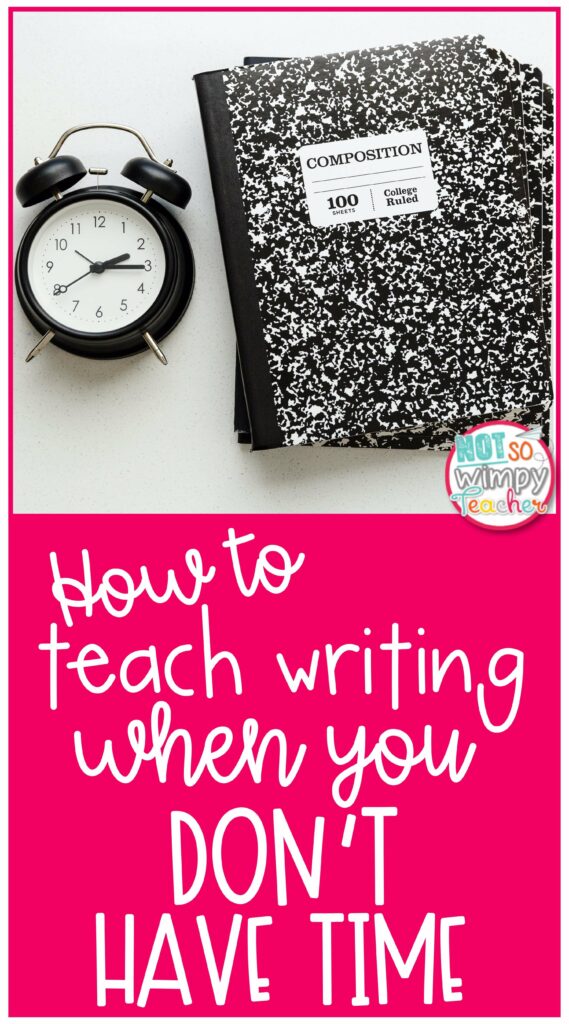
Have a Not So Wimpy Day!






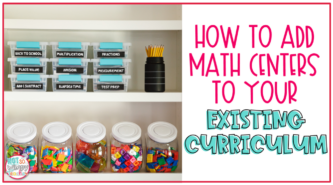
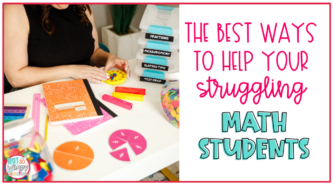
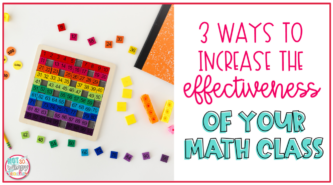











 End of Year Carnival Week for grades 2-5!
End of Year Carnival Week for grades 2-5!
I love your resources but will be teaching 1st grade next year. Do you have anything for first?
Hi Sheryl,
I am sorry, but we only create resources for grades 2-5. We create for these grade levels because we have the most experience teaching in these grades.
Hi there,
I took your writing master class the summer before last, loved it. I am wondering what your suggestion would be for making fewer copies? Our school has cracked down on paper/number of copies, etc. Do you think your system would work digitally?
Thank you,
Francine
Sure! We have lots of teachers who use the units digitally. Each of the writing units includes a digital writing notebook that has the student anchor charts. You could also share the mentor text digitally with your students.
Trying to sign up for writing class
Hi Harrian,
Thank you for your interest in the Writing Masterclass. The course sign-up has not quite started yet. Please click the Put Me on the Waitlist button above and we’ll notify you as soon as the doors open.
I’m going to be out of the country for the master class. Will it be offered in July or August?
Registration for the course only happens once a year. Once you register for the Masterclass, you can watch and rewatch the videos as often as you like and at your convenience. You have lifetime access to the material.
Hi, I saw on your schedules you had Word Study. Is that Vocabulary or spelling and if it’s not spelling, how do you fit that in. Thank you